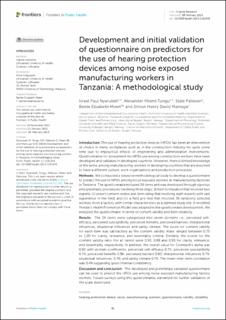| dc.contributor.author | Nyarubeli, Israel Paul | |
| dc.contributor.author | Tungu, Alexander Mtemi | |
| dc.contributor.author | Pallesen, Ståle | |
| dc.contributor.author | Moen, Bente Elisabeth | |
| dc.contributor.author | Mamuya, Simon Henry David | |
| dc.date.accessioned | 2023-05-25T09:32:48Z | |
| dc.date.available | 2023-05-25T09:32:48Z | |
| dc.date.created | 2023-03-07T19:00:00Z | |
| dc.date.issued | 2023-02-09 | |
| dc.identifier.issn | 2296-2565 | |
| dc.identifier.uri | https://hdl.handle.net/11250/3068973 | |
| dc.description.abstract | Introduction: The use of hearing protection devices (HPDs) has been an intervention of choice in many workplaces such as in the construction industry for quite some time due to impractical effects of engineering and administrative interventions. Questionnaires for assessment for HPDs use among construction workers have been developed and validated in developed countries. However, there is limited knowledge of the same, among manufacturing workers in developing countries that are assumed to have a different culture, work organizations and production processes.
Methods: We conducted a stepwise methodological study to develop a questionnaire to predict the use of HPDs among noise exposed workers in manufacturing factories in Tanzania. The questionnaire included 24 items and was developed through rigorous and systematic procedures involving three steps; (i) item formulation that involved two experts, (ii) expert content review and item rating that involving eight experts with vast experience in the field, and (iii) a field pre-test that involved 30 randomly selected workers from a factory with similar characteristics as a planned study site. A modified Pender's Health Promotion Model was adopted in the questionnaire development. We analyzed the questionnaire in terms of content validity and item reliability.
Results: The 24 items were categorized into seven domains i.e., perceived self-efficacy, perceived susceptibility, perceived benefits, perceived barriers, interpersonal influences, situational influences and safety climate. The score for content validity for each item was satisfactory as the content validity index ranged between 0.75 to 1.00 for clarity, relevance, and essentiality criteria. Similarly, the scores for the content validity ratio (for all items) were 0.93, 0.88 and 0.93 for clarity, relevance, and essentiality, respectively. In addition, the overall value for Cronbach's alpha was 0.92 with domain coefficients: perceived self-efficacy 0.75; perceived susceptibility 0.74; perceived benefits 0.86; perceived barriers 0.82; interpersonal influences 0.79; situational influences; 0.70; and safety climate 0.79. The mean inter-item correlation was 0.49 suggesting good internal consistency.
Discussion and conclusion: The developed and preliminary validated questionnaire can be used to predict the HPDs use among noise exposed manufacturing factory workers. Future surveys using this questionnaires warranted for further validation of the scale developed. | en_US |
| dc.language.iso | eng | en_US |
| dc.publisher | Frontiers | en_US |
| dc.rights | Navngivelse 4.0 Internasjonal | * |
| dc.rights.uri | http://creativecommons.org/licenses/by/4.0/deed.no | * |
| dc.title | Development and initial validation of questionnaire on predictors for the use of hearing protection devices among noise exposed manufacturing workers in Tanzania: A methodological study | en_US |
| dc.type | Journal article | en_US |
| dc.type | Peer reviewed | en_US |
| dc.description.version | publishedVersion | en_US |
| dc.rights.holder | Copyright 2023 the authors | en_US |
| dc.source.articlenumber | 1102343 | en_US |
| cristin.ispublished | true | |
| cristin.fulltext | original | |
| cristin.qualitycode | 1 | |
| dc.identifier.doi | 10.3389/fpubh.2023.1102343 | |
| dc.identifier.cristin | 2132125 | |
| dc.source.journal | Frontiers in Public Health | en_US |
| dc.identifier.citation | Frontiers in Public Health. 2023, 11, 1102343. | en_US |
| dc.source.volume | 11 | en_US |

